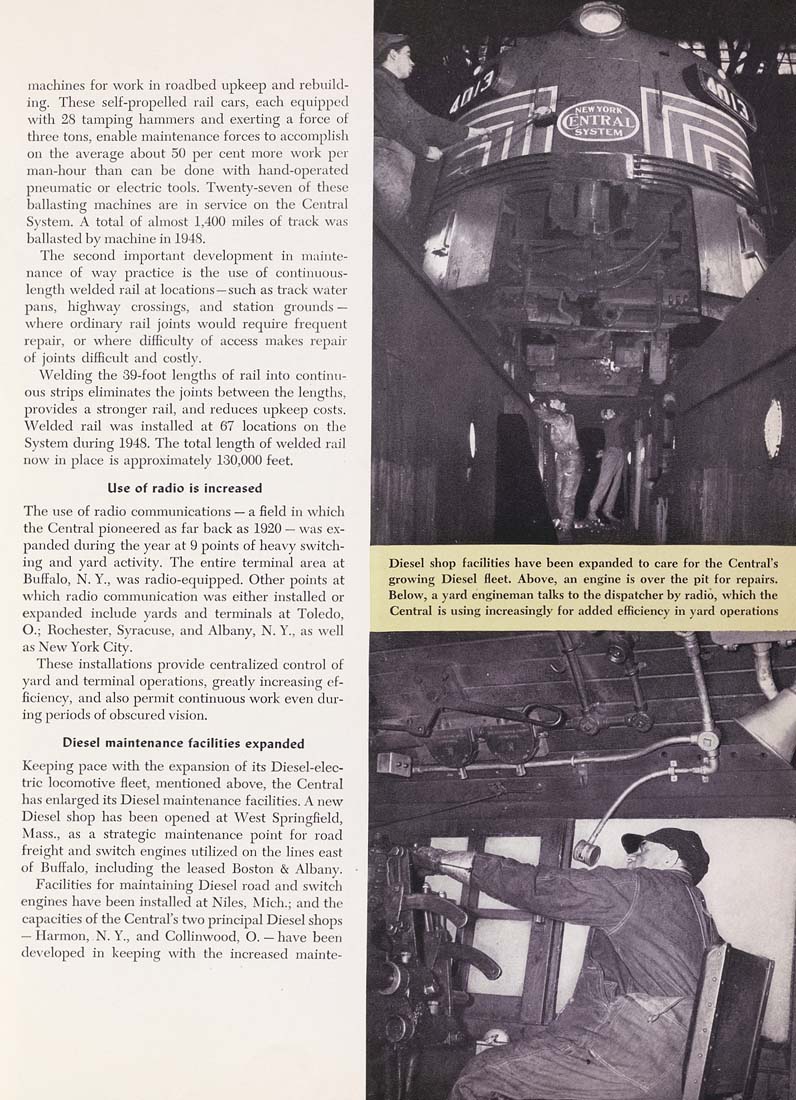machines for work in roadbed upkeep and rebuild¬
ing. These self-propelled rail cars, each equipped
with 28 tamping hammers and exerting a force of
three tons, enable maintenance forces to accomplish
on the average about 50 per cent more work per
man-hour tlian can be done with hand-operated
pneiunatic or electric tools. Twenty-seven of these
ballasting machines are in service on the Central
System. A total of almost 1,400 miles of track was
ballasted by machine in 1948.
The second important development in mainte¬
nance of way practice is tlie use of contimious-
length welded rail at locations—such as track water
pans, highway crossings, and station grounds —
where ordinary rail joints would require frequent
repair, or where difficulty of access makes rcpaii"
of joints difficult and costly.
Welding the 39-foot lengths of rail into continu¬
ous strips eliminates the joints between the lengths,
provides a stronger rail, and reduces upkeep costs.
Welded rail was installed at 67 locations on the
System during 1948. The total length of welded rail
now in place is approximately 130,000 feet.
Use of radio is increased
The use of radio commimications — a field in which
the Centi-al pioneered as far back as 1920 — was ex¬
panded during the year at 9 points of heavy switch¬
ing and yard activity. The entire terminal area at
Buffalo, N. Y., was radio-equipped. Other points at
which radio communication was either installed or
expanded include yards and terminals at Toledo,
O.; Rochester, Syracuse, and Albany, N. Y., as well
as New York City.
These installations provide centralized control of
yard and terminal operations, greatly increasing ef¬
ficiency, and also permit continuous work even dur¬
ing periods of obscured vision.
Diesel maintenance facilities expanded
Keeping pace with the expansion of its Diesel-elec¬
tric locomotive fleet, mentioned above, the Central
has enlarged its Diesel maintenance facihties. A new
Diesel shop has been opened at West Springfield,
Mass., as a strategic maintenance point for road
freight and switch engines utiHzed on the lines east
of Buffalo, including the leased Boston & Albany. ■
Facilities for maintaining Diesel road and switch
engines have been installed at Niles, Mich.; and the
capacities of the Cenhal's two principal Diesel shops
— Harmon, N. Y., and Collinwood, O. — have been
developed in keeping with the increased mainte-
Diesel shop facilities have been expanded to care for the Central's
growing Diesel fleet. Above, an engine is over the pit for repairs.
Below, a yard engineman talks to the dispatcher by radio, which the
Central is using increasingly for added efficiency in yard operations
|








